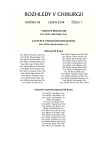Erectile dysfunction as a result of spinal trauma
Authors:
I. Dolan 1; T. Šrámková 2; P. Filipenský 1; K. Šramková 1
Authors‘ workplace:
Urologické oddělení, FN u sv. Anny v Brně, primář: MUDr. P. Filipenský Ph. D.
1; Klinika úrazové chirurgie FN Brno, přednosta: Doc. MUDr. M. Mašek, CSc.
2
Published in:
Rozhl. Chir., 2014, roč. 93, č. 1, s. 6-10.
Category:
Review
Overview
Erectile dysfunction (ED) is one of many consequences of spinal trauma. Its extent is influenced by several factors, depending mainly on the height of spinal injuries as well as the premorbid state. The incidence of spinal cord injuries in the Czech Republic and around the world has a slightly upward trend. Epidemiological statistics include mostly young people for whom sexual activity has a reproductive function. Disorders in the intimate area seriously and significantly reduce the quality of life. The article presents current theoretical knowledge of erectile dysfunction, according to epidemiological data on spinal cord injuries in the Czech Republic, and an overview of up-to-date therapeutic modalities for erectile dysfunction in men after spinal trauma.
Key words:
erectile dysfunction – spinal cord injury – therapy
Sources
1. Morelli A, Filippi S, Vignozzi L, et al. Physiology of erectile function: An update on intracellular molecular proceses. EAU-EBU update series 2006;4:97.
2. De Tejada IS, Angulo J, Cellek S, et al. Physiology of erectile function. J Sex Med 2004;1:254.
3. Anderson KE, Wagner G. Physiology of penile erection. Physiol Rev 1995;75:191–236.
4. Lue TF. Physiology of penile erection and pathophysiology of erectile dysfunction. In: Kavoussi LR, Peters CA, Novick A, Partin A. editors. Campbell-Walsh urology. Philadelphia, Saunders-Elsevier 2007:750–87.
5. Weiss P, et al. Sexuologie. 1. vyd. Praha, Grada Publishing 2010: 744.
6. Knútsdottir, et al. Epidemiology of traumatic spinal cord injuries in Iceland from 1975 to 2009. Spinal cord 2012;50:123–126.
7. Zachoval R, Krhut J. Traumatické dysfunkce dolních močových cest: Etiologie, prevalence a klasifikace. Urolog pro Praxi 2007;3:109–112.
8. Tator CH. Review of treatment trials in human spinal cord injury: issues, difficulties, and recommendations. Neurosurgery 2006;59: 957–982.
9. Česká společnost pro míšní léze. Statistiky. [on-line]. [cit. 2013-02-28]. Dostupný z http://www.spinalcord.cz/cz/statistiky.
10. Recommendation of the International Scientific Committee on the Evaluation and Treatment of Erectile Dysfunction. 1st International Consultation on Erectile Dysfunction, Paris 1999.
11. Šrámková T. Posttraumatická sexuální dysfunkce u pacientů s transverzální míšní lézí. Urolog pro Praxi 2008;9:282–286.
12. Breza J. Erektilné poruchy. 1. vyd. Martin, Osveta 1994.
13. Šrámková T. Sexuologicko-andrologické aspekty traumatických míšních lézí a kvalita života. Kandidátská dizertační práce. Brno 1998.
14. Phelps J, Albo M, Dunn K, Joseph A. Spinal cord injury and sexuality in married or partnered men: activities, function, needs, and predictors of sexual adjustment. Arch Sex Behav 2001; 30:591–602.
15. EAU Guidelines. [on-line]. [cit. 2013-02-28]. Dostupný na http://www.uroweb.org/guidelines/online-guidelines.
16. Francis SH, Turko IV, Corbin JD. Cyclic nucleotide phosphodiesterases: relating structure and function. Prog Nucleic Acid Res Mol Biol 2001;65:1–52.
17. Sanchez RA, Vidal J, Jáuregui ML, et al. Efficacy, safety and predictive factors of therapeutic success with sildenafil for erectile dysfunction in patients with different spinal cord injuries. Spinal cord 2001;39:637–643.
18. Ahn GJ, Yu JY, Choi SM, et al. Chronic administration of phosphodiesterase 5 inhibitor improves erectile and endothelial function in a rat model of diabetes. Int J Androl 2005;28:260–6.
19. McMahon C. Comparison of efficacy, safety and tolerability of on-demand tadalafil and daily dosed tadalafil for the treatment of erectile dysfunction. J Sex Med 2005;2:415–25.
20. Movaghar VR, Vaccaro A. Management of Sexual Disorders in Spinal Cord Injured Patients. Acta Medica Iranica 2012; 50:295–299.
21. Lakin MM, Montague DK, VanderBrug Medendorp S, et al. Intracavernous injection therapy: analysis of results and complications. J Urol 1990;143:1138–41.
22. Pacík, D. Penilní protézy: Jejich místo v léčbě erektilní dysfunkce a vlastní dlouhodobé zkušenosti. Urol praxi 2005;1:18–22.
23. Carson CC, Mulcahy JJ, Govier FE. Efficacy, safety and patient satisfaction outcomes of the AMS 700CX inflatable penile prosthesis: results of a long-term multicenter study. AMS 700CX Study Group. J Urol 2000;164:376–80.
24. Yang KM, Choi HK. Analysis of survival rate and cause of revision on penile prosthesis: A single center long term follow-up study. Korean J Urol 2005;46:1186–91.
25. Buch JP, Zorn BH, Taylor RJ. Cost-benefit analysis of pharmacologic erection program (PEP) versus penile prosthesis. Urology 1991;37:116–18.
26. Sievert KD, Amend B, Gakis G, et al. Early sacral neuromodulation prevents urinary incontinence after complete spinal cord injury. Ann Neurol 2010;67:74-84.
Labels
Surgery Orthopaedics Trauma surgeryArticle was published in
Perspectives in Surgery

2014 Issue 1
Most read in this issue
- Urine derivation after radical cystectomy
- Pelvic exenteration in the treatment of advanced tumours of the small pelvis
-
Is thyroid and parathyroid surgery safe?
Is it suitable for one-day surgery? - Biliary stent as a cause of bowel obstruction
